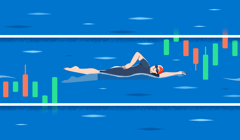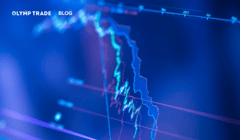
Despite the fact that the Andrews’ pitchfork and its modifications (Schiff Pitchfork) are quite a specific tool for market analysis, they are quite easy to use and plot on the graph. Any trader can easily master this tool and use it in their profession.
This article will explain how to use this tool and get the most out of it.
Contents:
- Trading channels in trading
- Building the Andrews’ Pitchfork
- How to use Pitchfork (Tradingview’s example)
- Conclusion
Interact with the underlined words and green dots to get additional details and explanations.
Additional context for the visuals.
Explanations and definitions of terms.
Trading channels in trading
In order to understand how Andrews’ Pitchfork works, let's first remember how trading channels are built. Channels can be built on any time frame and on any trend.

Support level.
Resistance level.
If the trend is bullish, then the channel will be directed upwards. A price drop (bearish trend) means that the channel will be directed down.
The channel's lower border will act as a support level, and the upper border will act as a resistance level.
A flat in the market means the channel lines will be horizontal.
Channels are widely used in indicator analysis of the market.

Resistance level.
Support level.
Only in this case, instead of channels, various indicators are used, for example Bollinger bands or a Donchian channel.
Channels are also used in wave analysis.
Building a reliable channel usually takes the two highest and two lowest lows.

In practice, this is not so simple since false breakouts are formed quite often, i.e., prices can cross channel boundaries and come back.
Building the Andrews’ Pitchfork
Alan Andrews, a financial educator, and trader, proposed in the 1960-70s to use a slightly different method of building trading channels.
Step 1️⃣. On an uptrend, the two lowest lows and one highest high are selected.

This method of constructing channels is called the Andrews’ Pitchfork. The method involves using three extremes to build a channel, and usually the channel is built in the presence of a pronounced bullish or bearish trend. So, how to draw Andrews’ Pitchfork?
Step 2️⃣. The distance between the last highest high and lowest low is halved.

BM = MC.
A straight line is drawn between these values through the center point from the first lowest low. This is the middle line of the pitchfork tool.
In our case, BM = MC.
Step 3️⃣. Completion of the pitchfork.

Through points B and C at a distance equal to BM, equal to MC, it is necessary to build the upper and lower lines, which actually complete the construction of the trading channel or Andrews’ Pitchfork.
On a bearish trend, Andrews' Pitchfork is built in the same way. However, the two highest highs and one lowest low are used.
How do you use a pitchfork in Tradingview?
Let's analyze the construction of an Andrews Pitchfork on a bearish trend on a "live" chart. As usual, we are choosing an asset and applying the pitchfork tool.
How to use Pitchfork (Tradingview’s example)
Pitchforks are used in much the same way as price channels are used. However, in the case of a pitchfork, one more additional line appears – the median. The rules are as follows:
- When the price returns to the middle line, then this line becomes a pivot point. In other words, the median line acts as a support or resistance level when the price moves.
- Before turning around, the price forms several small fluctuations around the median line. It’s also not surprising that quite often the price goes into a flat before a reversal.
- If the price cannot reach the median line, then it starts moving in the opposite direction for a long time although this rule does not always apply.
- If prices break up through the upper pitchfork line, this signals to buy. If the breakdown is to the bottom, this is a signal to sell.
Let's see how this works in practice. Here is a chart of the EUR/USD 1W TF pair.

Sell signal.
First, the price bounced off the middle line and started to decline. Then there was a breakdown of the bottom line of the Andrews’ Pitchfork, which gave a signal to open a down trade.
Conclusion
Proper use of market analysis tools is a step towards successful trading. The study of technical analysis allows the trader to see the patterns of price changes, and the Olymp Trade Blog is a source of an important element in trading – up-to-date information. Thanks to this, you can easily master the pitchfork tool trading.
Practice the skill of using analysis tools on a demo account and join trading on a real Olymp Trade account.
Go to PlatformRisk warning: The contents of this article do not constitute investment advice, and you bear sole responsibility for your trading activity and/or trading results.
A trend is the general direction of the price of a market, asset, or metric.
Bollinger Bands are a trading tool used to determine entry and exit points for a trade.
Donchian Channels are three lines generated by moving average calculations that comprise an indicator formed by upper and lower bands around a midrange or median band.
The Elliott Wave Theory is a form of technical analysis that looks for recurrent long-term price patterns related to persistent changes in investor sentiment and psychology.











